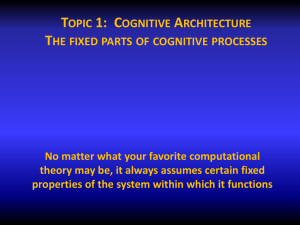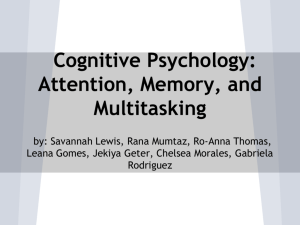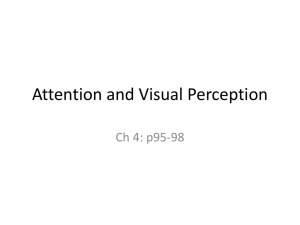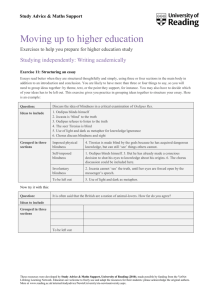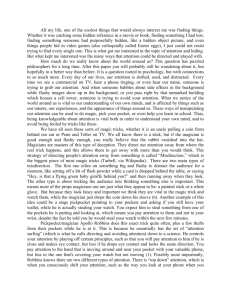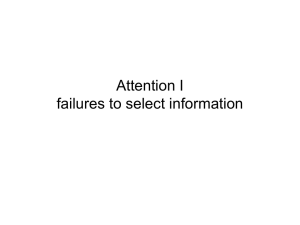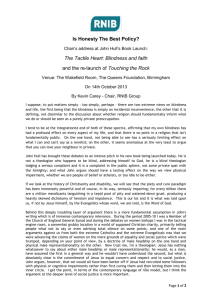Individual Differences in Susceptibility to Inattentional Blindness
advertisement
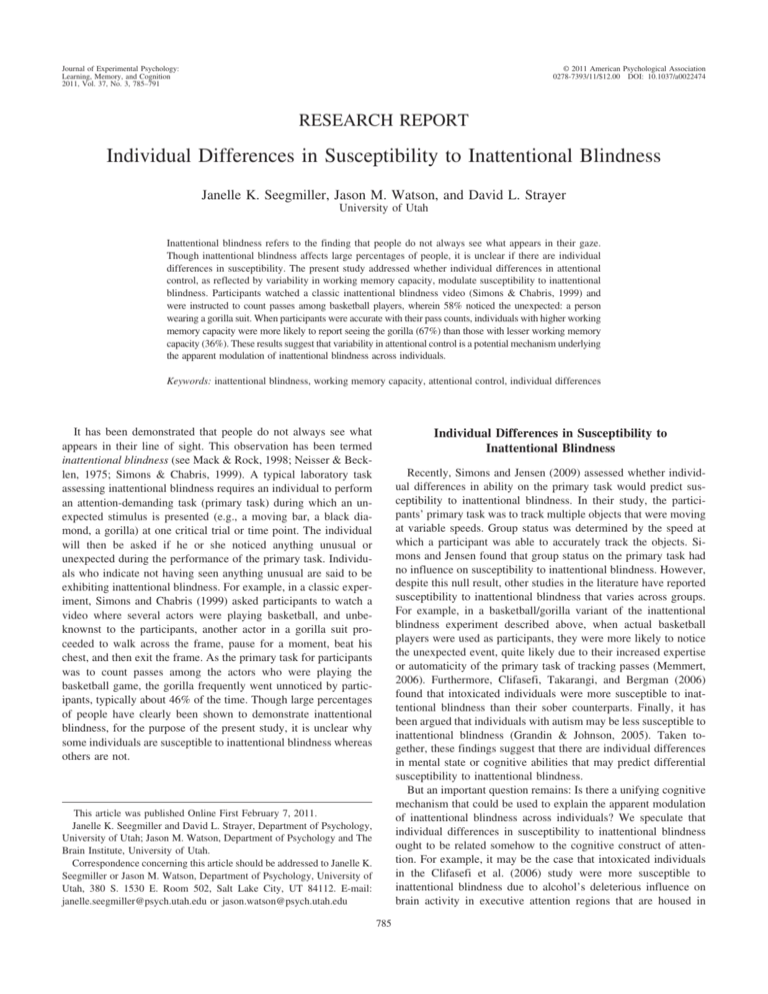
Journal of Experimental Psychology: Learning, Memory, and Cognition 2011, Vol. 37, No. 3, 785–791 © 2011 American Psychological Association 0278-7393/11/$12.00 DOI: 10.1037/a0022474 RESEARCH REPORT Individual Differences in Susceptibility to Inattentional Blindness Janelle K. Seegmiller, Jason M. Watson, and David L. Strayer University of Utah Inattentional blindness refers to the finding that people do not always see what appears in their gaze. Though inattentional blindness affects large percentages of people, it is unclear if there are individual differences in susceptibility. The present study addressed whether individual differences in attentional control, as reflected by variability in working memory capacity, modulate susceptibility to inattentional blindness. Participants watched a classic inattentional blindness video (Simons & Chabris, 1999) and were instructed to count passes among basketball players, wherein 58% noticed the unexpected: a person wearing a gorilla suit. When participants were accurate with their pass counts, individuals with higher working memory capacity were more likely to report seeing the gorilla (67%) than those with lesser working memory capacity (36%). These results suggest that variability in attentional control is a potential mechanism underlying the apparent modulation of inattentional blindness across individuals. Keywords: inattentional blindness, working memory capacity, attentional control, individual differences It has been demonstrated that people do not always see what appears in their line of sight. This observation has been termed inattentional blindness (see Mack & Rock, 1998; Neisser & Becklen, 1975; Simons & Chabris, 1999). A typical laboratory task assessing inattentional blindness requires an individual to perform an attention-demanding task (primary task) during which an unexpected stimulus is presented (e.g., a moving bar, a black diamond, a gorilla) at one critical trial or time point. The individual will then be asked if he or she noticed anything unusual or unexpected during the performance of the primary task. Individuals who indicate not having seen anything unusual are said to be exhibiting inattentional blindness. For example, in a classic experiment, Simons and Chabris (1999) asked participants to watch a video where several actors were playing basketball, and unbeknownst to the participants, another actor in a gorilla suit proceeded to walk across the frame, pause for a moment, beat his chest, and then exit the frame. As the primary task for participants was to count passes among the actors who were playing the basketball game, the gorilla frequently went unnoticed by participants, typically about 46% of the time. Though large percentages of people have clearly been shown to demonstrate inattentional blindness, for the purpose of the present study, it is unclear why some individuals are susceptible to inattentional blindness whereas others are not. Individual Differences in Susceptibility to Inattentional Blindness Recently, Simons and Jensen (2009) assessed whether individual differences in ability on the primary task would predict susceptibility to inattentional blindness. In their study, the participants’ primary task was to track multiple objects that were moving at variable speeds. Group status was determined by the speed at which a participant was able to accurately track the objects. Simons and Jensen found that group status on the primary task had no influence on susceptibility to inattentional blindness. However, despite this null result, other studies in the literature have reported susceptibility to inattentional blindness that varies across groups. For example, in a basketball/gorilla variant of the inattentional blindness experiment described above, when actual basketball players were used as participants, they were more likely to notice the unexpected event, quite likely due to their increased expertise or automaticity of the primary task of tracking passes (Memmert, 2006). Furthermore, Clifasefi, Takarangi, and Bergman (2006) found that intoxicated individuals were more susceptible to inattentional blindness than their sober counterparts. Finally, it has been argued that individuals with autism may be less susceptible to inattentional blindness (Grandin & Johnson, 2005). Taken together, these findings suggest that there are individual differences in mental state or cognitive abilities that may predict differential susceptibility to inattentional blindness. But an important question remains: Is there a unifying cognitive mechanism that could be used to explain the apparent modulation of inattentional blindness across individuals? We speculate that individual differences in susceptibility to inattentional blindness ought to be related somehow to the cognitive construct of attention. For example, it may be the case that intoxicated individuals in the Clifasefi et al. (2006) study were more susceptible to inattentional blindness due to alcohol’s deleterious influence on brain activity in executive attention regions that are housed in This article was published Online First February 7, 2011. Janelle K. Seegmiller and David L. Strayer, Department of Psychology, University of Utah; Jason M. Watson, Department of Psychology and The Brain Institute, University of Utah. Correspondence concerning this article should be addressed to Janelle K. Seegmiller or Jason M. Watson, Department of Psychology, University of Utah, 380 S. 1530 E. Room 502, Salt Lake City, UT 84112. E-mail: janelle.seegmiller@psych.utah.edu or jason.watson@psych.utah.edu 785 786 SEEGMILLER, WATSON, AND STRAYER frontal cortex (Dao-Castellana et al., 1998) and underlie goal maintenance. Therefore, we hypothesize that the differential susceptibility that has been observed in the inattentional blindness literature is due to individual differences in executive attention or attentional control. Consistent with this assertion, older adults are generally more susceptible to inattentional blindness than young adults (see Rizzo et al., 2009, on aging/change blindness), which may be due, at least in part, to age-related breakdowns in goal maintenance and attentional control (Watson, Lambert, Miller, & Strayer, in press). Individual Differences in Working Memory Capacity and Controlled Attention Relevant to the present theoretical discussion on attention is the argument that one of the primary functions of working memory is attentional control (Kane & Engle, 2002). Specifically, attentional control is used to maintain task goals in an active state in the presence of interfering information. From an attentional-control perspective, one might expect individual differences in working memory capacity to influence performance in cognitively challenging tasks that require the active maintenance of task goals in the face of potentially interfering information (Engle, 2002). Consistent with this reasoning, individuals with lower working memory capacity perform more poorly than individuals with higher working memory capacity in situations where successful performance is dependent on minimizing interference, including but not limited to dichotic listening, Stroop color naming, and associative false memory paradigms (see Conway, Cowan, & Bunting, 2001; Kane & Engle, 2003; Watson, Bunting, Poole, & Conway, 2005, respectively). For example, using the Stroop task where the participants’ goal is to name ink colors and to ignore distracting words, Kane and Engle (2003) found that in a 75% congruency condition, individuals with lower working memory capacity produced more naming errors than those with higher working memory capacity in the incongruent condition, and thus were more likely to be off task and to mistakenly say “red” to the stimulus RED printed in green ink. Earlier we speculated on the role of attentional control in modulating susceptibility to inattentional blindness. More specifically, it may be that individual differences in working memory capacity will predict differential susceptibility to inattentional blindness. There are some important methodological and theoretical similarities between research on working memory capacity and research on inattentional blindness that guide this prediction. For instance, consider that in both literatures, participants are often asked to maintain a primary task goal (e.g., count passes vs. name ink colors, respectively) while a potential source of interference is also presented (e.g., a gorilla vs. a word, respectively). Consistent with this idea, individual differences in working memory capacity have been shown to predict an auditory form of selective attention more commonly referred to as the cocktail party effect. The cocktail party effect is the real-world observation that, when in a noisy environment such as a party, people have the ability to attend to only their own conversation (with the exception of a salient stimulus such as one’s own name, which, for some, seems to capture attention fairly automatically). Using a variant of a dichotic listening paradigm developed by Cherry (1953) and Moray (1959), Conway et al. (2001) asked participants to shadow stimuli in one ear and to ignore stimuli in their other ear, where each participant’s name was unexpectedly presented in the unattended channel. As expected on the basis of the cocktail party effect literature, when questioned after completion of the task, about 40% of the participants did report hearing their own name during the experiment. However, Conway et al. also found that there were clear individual differences in susceptibility to the classic cocktail party phenomenon. That is, whereas 65% of the individuals with lower working memory capacity reported hearing their name, only 20% of the individuals with higher working memory capacity noticed their name. According to Conway et al., individuals with higher working memory capacity are more capable of inhibiting non-goal-related or distracting stimuli, even if it is as salient and emotionally relevant as one’s own name. Motivation for the Current Study and Predictions Thus, although there is preliminary support for the idea that individual differences in attentional control will modulate susceptibility to inattentional blindness, in the present study we sought to provide a strong test of this hypothesis by investigating the relationship between working memory capacity and inattentional blindness in a large sample of young adults. We believe there are two alternative predictions regarding the direction of the relationship between individual differences in working memory capacity and susceptibility to inattentional blindness. It is interesting that Conway and colleagues (2001) suggested two similar predictions for individual differences in susceptibility to the cocktail party effect. Given Conway et al.’s finding of decreased susceptibility to the cocktail party effect with higher working memory capacity, one would predict a positive relationship between working memory capacity and inattentional blindness. That is, if failing to notice a salient stimulus such as one’s own name generalizes to the “gorilla in the room” in a typical inattentional blindness experiment, individuals with greater working memory capacity will be more susceptible to inattentional blindness. However, this prediction overlooks at least one important methodological difference between the work of Conway et al. and prevailing inattentional blindness paradigms. Specifically, in the cocktail party effect study, participants were explicitly instructed to both attend to stimuli in one ear and to ignore stimuli in their other ear. In contrast, in a typical inattentional blindness study, participants are given a single task goal (e.g., count passes among the actors playing a basketball game), and hence, any additional goal(s) related to unexpected stimuli are ambiguous. Therefore, an alternative prediction is that individuals with greater working memory capacity will be less susceptible to inattentional blindness. According to this prediction, those with greater working memory capacity have more attentional resources at their disposal, and these resources can be used flexibly to permit greater attentional control (e.g., to actively inhibit potential distractions, or to distribute more broadly across multiple goals; see Conway et al., 2001, or Watson et al., in press, for similar arguments). If this is the case, individuals with greater working memory capacity will be better able to maintain a primary goal in an inattentional blindness study (e.g., counting passes), and they will also have enough residual attentional control to spontaneously monitor the environment for any unexpected stimuli (e.g., a go- INDIVIDUAL DIFFERENCES IN INATTENTIONAL BLINDNESS rilla). In contrast, individuals with lower working memory capacity will have just enough control to maintain the primary goal but little else and, thus, they will be more susceptible to inattentional blindness. Method Participants The participants were 197 undergraduates enrolled in psychology courses at the University of Utah. They participated in this study in exchange for research credits. All participants were fluent in English based on self-report and were between the ages of 18 and 35. Design and Materials Operation span test (OSPAN). Each participant completed an automated OSPAN test to obtain a measure of working memory capacity/attentional control (Unsworth, Heitz, Schrock, & Engle, 2005). In this task, participants were required to solve math problems followed by a to-be-remembered letter—for example, “Is (8/4) ⫹ 3 ⫽ 4? A.” After varying numbers of these equation–letter pairs, participants were prompted to recall all of the letters of each set in order. Trials were pseudorandomized such that participants were unable to predict the set size of upcoming equation–letter pairs (set size ranged from three to seven equation–letter pairs). Participants were given points equal to the set size when all of the letters in that set were recalled correctly in serial order (i.e., an absolute span score). Total operation span was defined as the sum of points across all of the individual recall periods, with a maximum possible score of 75 points. Math accuracy was also tracked, and feedback was provided to participants during the task. This feedback was intended to keep problem-solving accuracy above 85% and to encourage participants’ compliance with the dual-task math/memory instructions of the OSPAN task that should reveal individual differences in attentional control. Inattentional blindness task. Each participant watched the basketball/gorilla video originally used by Simons and Chabris (1999) to empirically demonstrate the psychological phenomenon of inattentional blindness. Specifically, participants viewed video footage (Simons, 2003), lasting about 24 s, of six individuals playing a game of basketball. These six individuals were divided into two different teams as designated by the color of their shirts (e.g., black or white). Each team passed a basketball among its three players, making two different types of passes, bounce and aerial. About halfway through the video, unbeknownst to the participants, an actor in a gorilla suit entered from the right view of the shot, proceeded to walk across the frame, paused for a moment in the middle of the frame just in front of the basketball game to beat his chest, and then exited from the left view of the shot (appearing for a total of about 8 s). Prior to watching the video, participants were instructed to keep a separate count of both the total number of bounce passes and the total number of aerial passes made by the team in black.1 To assess susceptibility to inattentional blindness, at the conclusion of the video, we asked participants for the two pass counts and if they noticed anything unusual in the video (e.g., a gorilla). 787 Procedure Following informed consent, participants were tested individually or in groups that ranged from two to five people while completing the OSPAN test. After a short break, each participant completed the inattentional blindness task during a one-on-one session with the experimenter. At the conclusion of the experiment, participants received a questionnaire that probed their knowledge of any of the tasks, particularly the inattentional blindness paradigm, administered in the study.2 Results Data Preparation The overall probability of inattentional blindness replicated the findings of Simons and Chabris (1999), with 58% of naı̈ve participants noticing the gorilla. Rather than assuming that participants are actively engaged in counting passes, prior to assessing whether individual differences in attentional control modulate susceptibility to inattentional blindness, it is important to consider the actual ability of participants to successfully comply with this primary task goal. Similar to the OSPAN task, compliance with the inattentional blindness task instructions can be quantified using an accuracy percentage. Participants were considered accurate if their overall pass count accuracy was 80% or above. Thus, the following formula was used: Accuracy ⫽ 兩共correct bounce pass count ⫺ participant’s bounce pass count兲兩 ⫹ 兩共correct aerial pass count ⫺ participant’s aerial pass count兲兩. This formula takes into account the fact that participants were asked to maintain two separate pass counts— bounce and aerial. 1 For the video type and task difficulty used in the present study, Simons and Chabris (1999) reported little difference in noticing the gorilla between those participants who counted passes among the team in white (50%) or the team in black (58%). Hence, though we opted to have participants count passes among the team in black, it is unlikely to have influenced our results or primary conclusions. 2 Overall, there were 306 participants in the current study. Participants were removed from analyses reported in the text due to computer/ experimenter error (N ⫽ 10) or for failing to maintain high accuracy (i.e., ⱖ80%) on the math portion of the OSPAN task (N ⫽ 9). Math errors included those due to incorrect responses as well as failures to respond within the allotted time (see Unsworth et al., 2005, for additional details). As is typically done with inattentional blindness paradigms (cf. Simons & Chabris, 1999), several participants (N ⫽ 90) also had to be removed from our analyses due to self-reported knowledge of the inattentional blindness task, which might increase the likelihood of noticing the gorilla. Inattentional blindness, often in conjunction with the gorilla video, is a lecture topic in many of the undergraduate psychology courses that contribute volunteers to the human subject pool at Utah. Overall, as might be expected were participants accurate in their self-report, this nonnaı̈ve group (80% noticing of the gorilla) was not as susceptible to inattentional blindness as the naı̈ve group (58% noticing of the gorilla). After applying these three exclusionary criteria, all of the remaining participants (N ⫽ 197) were included in the analyses reported in the Results section. SEEGMILLER, WATSON, AND STRAYER Analysis of Individual Differences in Susceptibility to Inattentional Blindness A hierarchical binary logistic regression analysis was then conducted to assess the role that working memory capacity and pass count accuracy might play in the likelihood of a participant’s noticing the gorilla (cf. Colflesh & Conway, 2007). For this analysis, working memory capacity and pass count accuracy were entered in the first step, and the interaction of these two variables was entered in the second step. Working memory capacity was centered and treated as a continuous variable. Pass count accuracy was dichotomous, with accurate/on-task counts coded as 1 and inaccurate/off-task counts coded as 0. In the first step of this analysis, neither the main effect of working memory capacity nor the main effect of pass count accuracy was significant (Wald ⫽ 1.02 and 1.9, respectively). However, in the second step, the results indicated a significant effect of working memory capacity (Wald ⫽ 4.74, p ⬍ .05, odds ratio [OR] ⫽ 1.06), but there was still no effect of pass count accuracy (Wald ⫽ 2.03). Most important, there was a significant interaction of working memory capacity and pass count accuracy (Wald ⫽ 3.97, p ⬍ .05, OR ⫽ .97). This interaction suggested that the likelihood of noticing the gorilla was dependent on both working memory capacity and pass count accuracy. To better understand the nature of this interaction and to facilitate a comparison between the present results and the extant literature on individual differences in attentional control, we further compared two extreme categories of participants: high span and low span (Colflesh & Conway, 2007; Conway et al., 2001; Conway et al., 2005). High spans scored in the uppermost quartile on the OSPAN/working memory capacity measure, whereas low spans scored in the lowermost quartile.3 Due to the interaction found between working memory capacity and pass count accuracy (described above), we conducted separate chi-square analyses for participants with accurate versus inaccurate pass counts. As shown in the top half of Figure 1, when participants were on-task/accurate with their pass counts, high spans (67%) were about twice as likely to notice the gorilla as low spans (36%), 2(1) ⫽ 3.85, p ⬍ .05. In contrast, as shown in the bottom half of Figure 1, when participants were off-task/inaccurate with their pass counts, high (64%) and low spans (71%) did not differ significantly in noticing the gorilla, 2(1) ⫽ .31, p ⫽ .58. Discussion There are two important points to note about the results of the present study. First, our results replicated the original Simons and On-Task 1.0 % Noticing of the Gorilla To achieve the 80% accuracy criterion that reflected on-task performance, a summed accuracy score of ⱕ4 was required. This score could be achieved in a variety of ways—for example, 4 ⫽ 兩(8 ⫺ 6)兩 ⫹ 兩(12 ⫺ 14)兩 or 4 ⫽ 兩(8 ⫺ 4)兩 ⫹ 兩(12 ⫺ 12)兩]. The correct pass counts (i.e., 8 bounce and 12 aerial passes, respectively) were determined by examining still shots of each frame in the single action sequence of the gorilla video from Simons and Chabris (1999). Consistent with the broader working memory capacity literature indicating individual differences in goal maintenance and underlying attentional control, participants with higher OSPAN scores were more likely to be on-task with respect to their pass counts (r ⫽ .19, p ⬍ .05). 0.8 0.6 0.4 0.2 0.0 High Low Operation Span Off-Task 1.0 % Noticing of the Gorilla 788 0.8 0.6 0.4 0.2 0.0 Low High Operation Span Figure 1. Percentage noticing the gorilla as a function of performance on the operation span task. As shown in the top panel, for those participants who were on task with respect to their pass counts, individuals with low operation span scores were less likely to notice the gorilla, and hence, were more susceptible to inattentional blindness. However, as shown in the bottom panel, if participants were off task with pass counts, there was no relationship between susceptibility to inattentional blindness and individual differences in operation span performance. Taken together, these results indicate that individual differences in attentional control influence susceptibility to inattentional blindness. 3 To better represent the distribution of possible scores, we sorted participants on the basis of their absolute OSPAN performance prior to the removal of the nonnaı̈ve participants, as described in Footnote 2. In general, the summary statistics on the absolute OSPAN measure for our participants (M ⫽ 40.97, SD ⫽ 18.16, skewness ⫽ ⫺.36, kurtosis ⫽ ⫺.59, upper quartile ⫽ 55, lower quartile ⫽ 27) compared favorably with those originally reported by Unsworth et al. (2005) with the automated OSPAN test. INDIVIDUAL DIFFERENCES IN INATTENTIONAL BLINDNESS Chabris (1999) experiment with regard to the overall probability of inattentional blindness. Second, and more important, we demonstrated that individual differences in working memory capacity (OSPAN performance) modulated susceptibility to inattentional blindness. When participants had accurate pass counts, those with lower working memory capacity were more susceptible to inattentional blindness, failing to notice the gorilla, than those with higher working memory capacity. In this way, our inattentional blindness results are consistent with a growing body of literature on working memory capacity indicating that performance on many cognitive psychology tasks—including Stroop color naming, the cocktail party phenomenon, and associative memory illusions—is dependent on individual differences in attentional control (Engle, 2002; Watson et al., 2005). Theoretical Implications of Individual Differences in Susceptibility to Inattentional Blindness First, consider the potential implication of our inattentional blindness results for theories of controlled attention and individual differences in frontally mediated working memory capacity (Kane & Engle, 2002; Watson et al., in press). To place our results in an appropriate context, it is noteworthy that the literature contains several examples of studies in which individuals with greater working memory capacity perform better than those with lower working memory capacity at simultaneously maintaining two explicitly stated task goals. For instance, individuals with greater working memory capacity are better at simultaneously memorizing letters or words while solving math problems, as in an OSPAN task (or comparable complex span tasks that divide attention; Conway et al., 2005). As noted earlier, individuals with greater working memory capacity, as measured by OSPAN performance, are also better at attending to ink colors while actively inhibiting words, or selective attention, as in the classic Stroop task (Kane & Engle, 2003). Both findings support the notion that the increased attentional control afforded by greater working memory capacity can be used in a highly flexible manner and can be readily configured to meet task demands. Consistent with this argument, in a follow-up study to Conway et al. (2001), Colflesh and Conway (2007) found that individuals with greater working memory capacity were more likely to notice their own name, the opposite of what had been reported by Conway et al. in their original study on the cocktail party effect. The critical methodological difference between Conway et al. and Colflesh and Conway appears to be the task instructions. In Conway et al., the participants’ goal was to shadow the message in one ear while actively ignoring the message in their other ear (i.e., selective attention, where their name was presented in the unattended channel). In contrast, in Colflesh and Conway, the participants’ goal was to shadow the message in one ear while simultaneously attempting to listen for their name in the other ear (i.e., divided attention). Returning to the present study, our inattentional blindness results extend this notion of more flexible thought with greater attentional control in an important way. Our participants were instructed only to count passes; hence, any additional task goals with regard to the gorilla were ambiguous. In contrast to the two cocktail party effect/dichotic listening studies discussed above, participants were not explicitly told either to ignore or to attend to 789 possible distractions. Yet, as shown in the top half of Figure 1, individuals with greater working memory capacity spontaneously utilized their greater attentional control to detect an unusual stimulus that appeared (the gorilla), thereby decreasing susceptibility to inattentional blindness. It is noteworthy that adaptive or flexible processing, including heightened responding to novel or unexpected stimuli with greater frontally mediated executive attention (Fougnie & Marois, 2007; Kiehl, Laurens, Duty, Forster, & Liddle, 2001; Knight, 1991), is characteristic of higher order cognition (Fuster, 1985). With respect to implications for designing studies that investigate individual differences in susceptibility to inattentional blindness, our results suggest that there are two important methodological points to consider. First, one’s ability to observe possible individual differences in susceptibility to inattentional blindness is predicated upon establishing that participants are compliant with primary task goals. As shown in the bottom half of Figure 1, we did not observe a relationship between individual differences in working memory capacity and susceptibility to inattentional blindness when participants were inaccurate or off task with the primary goal of counting passes. Second, though being accurate or on task with a primary goal is necessary for observing individual differences in susceptibility to inattentional blindness, in and of itself, it is clearly not sufficient. One must also characterize individual differences in terms of attentional control (Engle, 2002), or more specifically, variability in participants’ ability to successfully maintain task goals (e.g., counting passes) in the face of potentially interfering information (e.g., a gorilla). Consistent with this argument, Simons and Jensen (2009) used a multiple object tracking task and investigated the relationship between individual differences in tracking speed and susceptibility to inattentional blindness. Prior to assessing noticing rates, variability in tracking speed was determined adaptively for each participant to achieve a uniform 75% accuracy threshold, thereby ensuring that all participants were on task. It is interesting that individual differences in this processing speed measure were not correlated with noticing rates. In contrast, Hannon and Richards (2010) used a multiple object tracking task that was very similar to Simons and Jensen’s and reported that individual differences in working memory capacity, indexed by varying OSPAN scores, did modulate noticing rates. More specifically, Hannon and Richards found that individuals who noticed the unexpected stimuli in their object tracking task had slightly higher OSPAN scores than those who failed to notice the unexpected stimuli. Thus, noticing was the independent variable for sorting participants, and OSPAN scores were the dependent variable (the opposite of the approach illustrated in Figure 1). Hannon and Richards also obtained a significant correlation between susceptibility to inattentional blindness and working memory capacity, where those with greater OSPAN scores were less susceptible to inattentional blindness. Why do individual differences in working memory capacity predict susceptibility to inattentional blindness, whereas variability in object tracking speed does not? One possible explanation for the discrepancy stems from the observation that measures of working memory capacity and processing speed appear to capture somewhat distinct aspects of cognition (McCabe, Roediger, McDaniel, Balota, & Hambrick, 2010). Working memory capacity measures such as OSPAN are an especially sensitive measure of individual differences in controlled cognition or the management of distrac- SEEGMILLER, WATSON, AND STRAYER 790 tion. Furthermore, with respect to underlying mechanisms, cognitive control is driven, at least in part, by the flexible allocation and configuration of executive attention in response to task demands by prefrontal cortex (Colflesh & Conway, 2007; Kane & Engle, 2002; Watson et al., in press). Hence, to the extent one is on task/accurate on a primary goal in an inattentional blindness study, individual differences in working memory capacity may be an ideal proxy for quantifying the residual attentional control that is available for noticing unexpected stimuli and for predicting noticing rates. By comparison, processing speed estimates may be less sensitive to the mechanisms that underlie the coordination of attentional control in response to varying task demands. In this light, the results of our study resolve an emerging discrepancy in the literature and suggest that there are indeed individual differences in cognitive ability that underlie differential susceptibility to inattentional blindness. Furthermore, as is traditionally done within the working memory capacity literature, our participants were sorted into varying levels of attentional control to address a particular research question. In contrast to Hannon and Richards (2010), OSPAN performance was the independent variable, and susceptibility to inattentional blindness was the dependent variable. As illustrated in Figure 1, the primary advantage of this approach is that it facilitates estimates of the relative susceptibility to inattentional blindness across different levels of working memory capacity, allowing one to cautiously ascribe a causal role to individual differences in attentional control (cf. Colflesh & Conway, 2007, or Conway et al., 2001, who quantified susceptibility to the cocktail party effect for those with high and low working memory capacity; see Engle, 2002). Conclusions and Future Directions The results of the present study demonstrate that individual differences in working memory capacity modulate susceptibility to inattentional blindness. When our participants had on-task/ accurate pass counts, those with lower working memory capacity were more likely to exhibit inattentional blindness than those with higher working memory capacity. In this way, our results are consistent with other recent studies suggesting that diminished attentional control increases the likelihood of missing unexpected events (see Rizzo et al., 2009, for evidence of greater susceptibility to change blindness in older adults and Alzheimer’s patients). Future studies addressing potential individual differences in susceptibility to inattentional blindness may find it useful to directly compare the predictive ability of working memory capacity with other cognitive measures (e.g., processing speed, personality profiles) within the same participants. Our results clearly suggest that considering working memory capacity, or variability in flexible attentional control, is a fruitful approach to identify mechanisms that underlie individual differences in susceptibility to inattentional blindness. References Cherry, E. C. (1953). Some experiments upon the recognition of speech, with one and with two ears. Journal of the Acoustical Society of America, 25, 975–979. doi:10.1121/1.1907229 Clifasefi, S. L., Takarangi, M. K. T., & Bergman, J. S. (2006). Blind drunk: The effects of alcohol on inattentional blindness. Applied Cognitive Psychology, 20, 697–704. doi:10.1002/acp.1222 Colflesh, G. J. H., & Conway, A. R. A. (2007). Individual differences in working memory capacity and divided attention in dichotic listening. Psychonomic Bulletin & Review, 14, 699 –703. Conway, A. R. A., Cowan, N., & Bunting, M. (2001). The cocktail party phenomenon revisited: The importance of working memory capacity. Psychonomic Bulletin & Review, 8, 331–335. Conway, A. R. A., Kane, M., Bunting, M., Hambrick, D., Wilhelm, O., & Engle, R. (2005). Working memory span tasks: A methodological review and user’s guide. Psychonomic Bulletin & Review, 12, 769 –786. Dao-Castellana, M. H., Samson, Y., Legault, F., Martinot, J. L., Aubin, H. J., Crouzel, C., . . . Syrota, A. (1998). Frontal dysfunction in neurologically normal chronic alcoholic subjects: Metabolic and neuropsychological findings. Psychological Medicine, 28, 1039 –1048. doi: 10.1017/S0033291798006849 Engle, R. (2002). Working memory capacity as executive attention. Current Directions in Psychological Science, 11, 19 –23. doi:10.1111/14678721.00160 Fougnie, D., & Marois, R. (2007). Executive working memory load induces inattentional blindness. Psychonomic Bulletin & Review, 14, 142– 147. Fuster, J. M. (1985). The prefrontal cortex, mediator of cross-temporal contingencies. Human Neurobiology, 4, 169 –179. Grandin, T., & Johnson, C. (2005). Animals in translation: Using the mysteries of autism to decode animal behavior. New York, NY: Simon & Schuster. Hannon, E. M., & Richards, A. (2010). Is inattentional blindness related to individual differences in visual working memory capacity or executive control functioning? Perception, 39, 309 –319. doi:10.1068/p6379 Kane, M. J., & Engle, R. W. (2002). The role of prefrontal cortex in working-memory capacity, executive attention, and general fluid intelligence: An individual-differences perspective. Psychonomic Bulletin & Review, 9, 637– 671. Kane, M. J., & Engle, R. W. (2003). Working-memory capacity and the control of attention: The contributions of goal neglect, response competition, and task set to Stroop interference. Journal of Experimental Psychology: General, 132, 47–70. doi:10.1037/0096-3445.132.1.47 Kiehl, K. A., Laurens, K. R., Duty, T. L., Forster, B. B., & Liddle, P. F. (2001). Neural sources involved in auditory target detection and novelty processing: An event-related fMRI study. Psychophysiology, 38, 133– 142. doi:10.1111/1469-8986.3810133 Knight, R. T. (1991). Evoked potential studies of attention capacity in human frontal lobe lesions. In H. S. Levin, H. M. Eisenberg, & A. L. Benton (Eds.), Frontal lobe function and dysfunction (pp. 139 –153). New York, NY: Oxford University Press. Mack, A., & Rock, I. (1998). Inattentional blindness. Cambridge, MA: MIT Press. McCabe, D. P., Roediger, H. L., McDaniel, M. A., Balota, D. A., & Hambrick, D. Z. (2010). The relationship between working memory capacity and executive functioning: Evidence for a common executive attention construct. Neuropsychology, 24, 222–243. doi:10.1037/ a0017619 Memmert, D. (2006). The effects of eye movements, age, and expertise on inattentional blindness. Consciousness and Cognition, 15, 620 – 627. doi:10.1016/j.concog.2006.01.001 Moray, N. (1959). Attention in dichotic listening: Affective cues and the influence of instructions. Quarterly Journal of Experimental Psychology, 11, 56 – 60. doi:10.1080/17470215908416289 Neisser, U., & Becklen, R. (1975). Selective looking: Attending to visually specified events. Cognitive Psychology, 7, 480 – 494. doi:10.1016/00100285(75)90019-5 Rizzo, M., Sparks, J. D., McEvoy, S., Viamonte, S., Kellison, I., & Vecera, S. P. (2009). Change blindness, aging, and cognition. Journal of Clinical and Experimental Neuropsychology, 31, 245–256. doi:10.1080/ 13803390802279668 INDIVIDUAL DIFFERENCES IN INATTENTIONAL BLINDNESS Simons, D. J. (2003). Surprising studies of visual awareness [DVD]. Champaign, IL: Viscog Productions. Simons, D. J., & Chabris, C. F. (1999). Gorillas in our midst: Sustained inattentional blindness for dynamic events. Perception, 28, 1059 –1074. doi:10.1068/p2952 Simons, D. J., & Jensen, M. S. (2009). The effects of individual differences and task difficulty on inattentional blindness. Psychonomic Bulletin & Review, 16, 398 – 403. doi:10.3758/PBR.16.2.398 Unsworth, N., Heitz, R., Schrock, J., & Engle, R. (2005). An automated version of the operation span task. Behavior Research Methods, 37, 498 –505. Watson, J. M., Bunting, M., Poole, B., & Conway, A. (2005). Individual 791 differences in susceptibility to false memory in the Deese–Roediger– McDermott paradigm. Journal of Experimental Psychology: Learning, Memory, and Cognition, 31, 76 – 85. doi:10.1037/0278-7393.31.1.76 Watson, J. M., Lambert, A. E., Miller, A. E., & Strayer, D. L. (in press). The magical letters P, F, C, and sometimes U: The rise and fall of executive attention with the development of prefrontal cortex. In K. L. Fingerman, C. Berg, J. Smith, & T. C. Antonucci (Eds.), Handbook of life-span development. New York, NY: Springer Publishing. Received June 4, 2010 Revision received November 24, 2010 Accepted November 30, 2010 䡲
